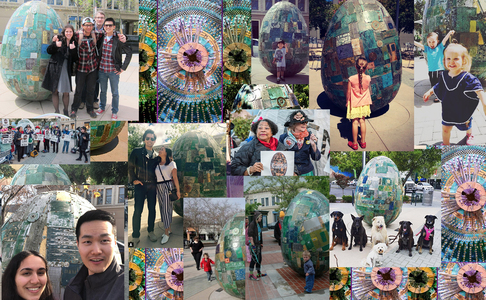100 signatures reached
To: City of Palo Alto Public Art Commission
Keep and Maintain Digital DNA (Save the Egg!)

Petition Text
We ask the City of Palo Alto to keep its iconic sculpture Digital DNA in its current location and properly maintain it.
Why is this important?
Unveiled in 2005, Digital DNA is very arguably the most popular and culturally significant work of public art the City has ever commissioned.
(As one measure of the work's popularity and impact, searching Instagram public posts by #[artwork title] shows that through 2017 Digital DNA had by an extraordinarily wide margin more posts than all of the City's other permanent sculptures combined, comparable to the number of posts of Rodin's Burghers of Calais at Stanford University.)
Digital DNA is so popular in part because it recognizes Palo Alto (indeed, the HP garage) as the birthplace of the Silicon Valley and the computer revolution in such a visually engaging, almost whimsical way. At the same time, the sculpture poses challenging questions about what it means to live and work in the Silicon Valley where every day companies determine and produce new technologies and make decisions that profoundly change the DNA of both it and every other society on the globe.
Based on social media metrics, it appears that Digital DNA has resonated with Palo Alto citizens and visitors alike to a much greater extent than any other permanent public artwork commissioned by the City. Visitors from all over the world make a point to visit Digital DNA as part of their exploration of Silicon Valley. Can the same be said of any other public artwork in Palo Alto? When the City does succeed in commissioning artwork that has significant popular and cultural impact as it has with Digital DNA, it seems self-evident that its Public Arts staff should concentrate its efforts and resources on properly maintaining such work. Otherwise, the City will find itself expending significant financial resources to acquire and maintain a collection of public artwork that has much lower public impact.
It is clear that the City can properly maintain Digital DNA. In 2015, the City hired ARG, a leading San Francisco arts conservator, to provide guidance on maintaining its outdoor public art. ARG advised the City that if a "water based coating is applied annually and the artwork inspected regularly, it will be acceptable to keep [Digital DNA] in its current location." After it had spent taxpayer funds to obtain it, the City omitted ARG’s assessment from it Deaccession Request for Digital DNA even though its Deaccession Policy requires it to include the opinion of a "qualified visual arts conservator."
Experienced arts caretakers such as the Getty Museum have routinely maintained outdoor plastic sculptures in excellent condition for many decades through regular maintenance and periodic restoration. There is no excuse for the City not to maintain Digital DNA using these same standard procedures. The cost of maintaining Digital DNA through annual maintenance and periodic restoration as needed is several thousand dollars per year, a small price to maintain very arguably the City's most successful public artwork and a tiny fraction of its total Public Arts budget.
(As one measure of the work's popularity and impact, searching Instagram public posts by #[artwork title] shows that through 2017 Digital DNA had by an extraordinarily wide margin more posts than all of the City's other permanent sculptures combined, comparable to the number of posts of Rodin's Burghers of Calais at Stanford University.)
Digital DNA is so popular in part because it recognizes Palo Alto (indeed, the HP garage) as the birthplace of the Silicon Valley and the computer revolution in such a visually engaging, almost whimsical way. At the same time, the sculpture poses challenging questions about what it means to live and work in the Silicon Valley where every day companies determine and produce new technologies and make decisions that profoundly change the DNA of both it and every other society on the globe.
Based on social media metrics, it appears that Digital DNA has resonated with Palo Alto citizens and visitors alike to a much greater extent than any other permanent public artwork commissioned by the City. Visitors from all over the world make a point to visit Digital DNA as part of their exploration of Silicon Valley. Can the same be said of any other public artwork in Palo Alto? When the City does succeed in commissioning artwork that has significant popular and cultural impact as it has with Digital DNA, it seems self-evident that its Public Arts staff should concentrate its efforts and resources on properly maintaining such work. Otherwise, the City will find itself expending significant financial resources to acquire and maintain a collection of public artwork that has much lower public impact.
It is clear that the City can properly maintain Digital DNA. In 2015, the City hired ARG, a leading San Francisco arts conservator, to provide guidance on maintaining its outdoor public art. ARG advised the City that if a "water based coating is applied annually and the artwork inspected regularly, it will be acceptable to keep [Digital DNA] in its current location." After it had spent taxpayer funds to obtain it, the City omitted ARG’s assessment from it Deaccession Request for Digital DNA even though its Deaccession Policy requires it to include the opinion of a "qualified visual arts conservator."
Experienced arts caretakers such as the Getty Museum have routinely maintained outdoor plastic sculptures in excellent condition for many decades through regular maintenance and periodic restoration. There is no excuse for the City not to maintain Digital DNA using these same standard procedures. The cost of maintaining Digital DNA through annual maintenance and periodic restoration as needed is several thousand dollars per year, a small price to maintain very arguably the City's most successful public artwork and a tiny fraction of its total Public Arts budget.

